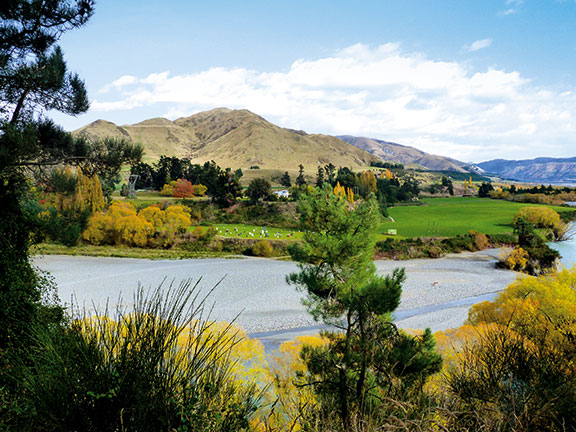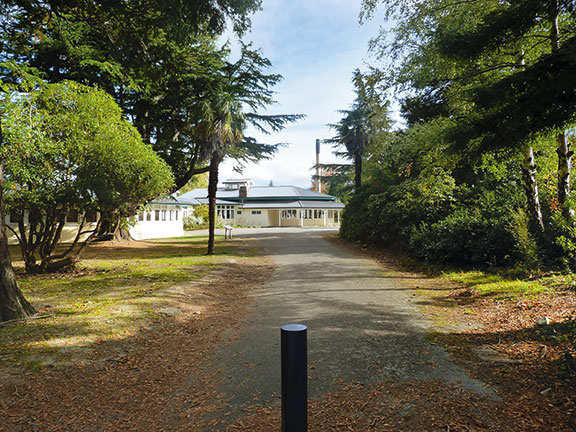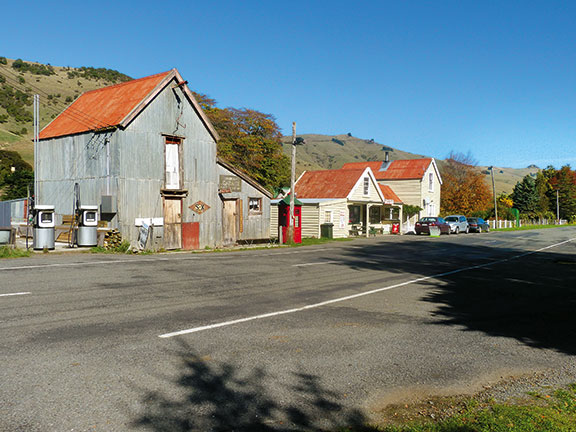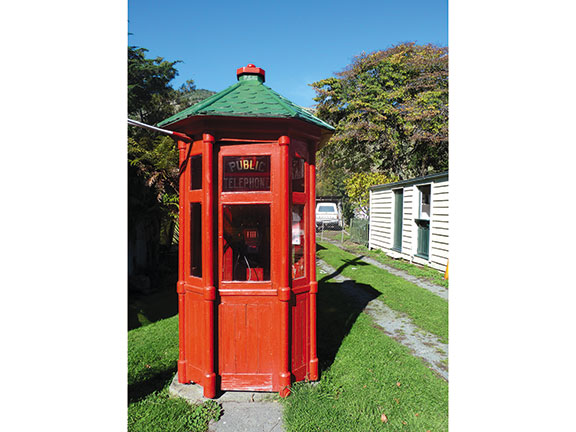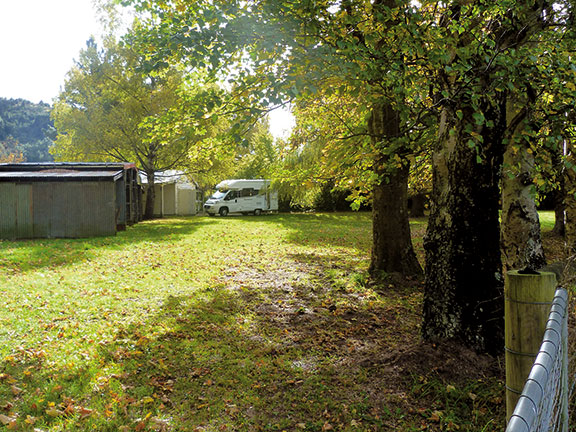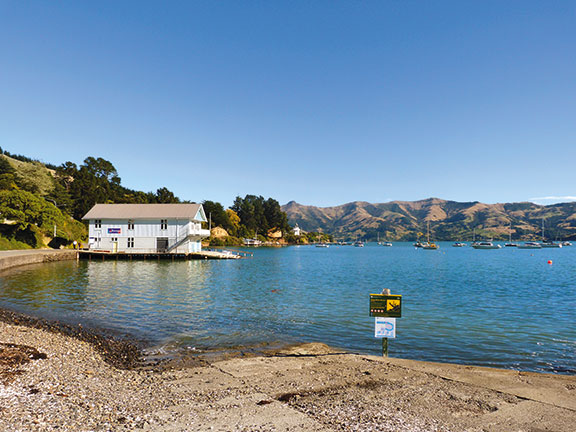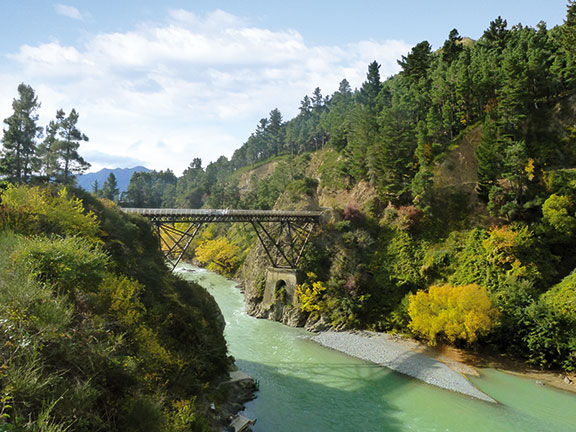The late afternoon light of a golden autumn day slanted through the roadside poplars as we eased our vehicle onto another long and beckoning one-way bridge. Below us, the milky turquoise water trickling through the river bed below hinted of a recent rain.
The hills themselves were a light shade of green. They may have been jealous of the surrounding trees, resplendent in every type of yellow from sienna to gold, and russets from a deep burnished red to a bone-dry brown. A cloudless cobalt sky defied the date. It was the last week of April and I had been told to expect a bitter, bone-seeping cold. Instead I was hopefully searching through bags of heavy clothes for something fresh and light.
I should not have been surprised. The day before, the deeply moving Anzac Day ceremony at Victoria Park had failed to deliver the anticipated crisp dawn. Far below us the city was shrouded in a smoky fog, but here — high on the ridgeline of the Port Hills — I found myself overdressed. By mid-morning we were positively gasping for air as we headed the car to Banks Peninsula on a single-lane shingle road with a terrifying drop off to the valley deep below. It was exhilarating.
Winding down to Pigeon Bay through intermittent patches of remnant bush we encountered a pair of horse riders heading for the hills. With their languid passing, time slowed. We negotiated the last of the hairpin bends and drove on past mature orchards and the handful of quaint colonial dwellings close to the water's edge.
It's easy to reflect on a time when Pigeon Bay was a horse-and-dray town serviced solely from the sea. There's a gnarled and generous old wharf, now mostly used by the local boating club. Nearby a broad grassed area abuts the waterfront campground, dotted with vintage caravans — their striped awnings still very much in evidence, even if the owners were not. There's a tennis court and children's playground. It's an idyllic setting for summer holidaymakers.
We couldn't have imagined a more peaceful place. Although a shock was in store for us as we clambered the narrow coastal path, when the co-pilot inadvertently grabbed a strand of electric fence while trying to take a closer peek at a gracious old mansion. A loud crack whipped through the air as he was thrown backwards. Thankfully he was not hurt, for I confess I was not kind — although I tried to be when I could suppress my merciless laughter.
If laughter soothes the soul, the dramatic scenery juxtaposed with the historic buildings of the nearby settlement of Okains Bay was to prove a further salve. The first European settlers of Okains Bay were the whalers in the 1840s. They were followed by farmers and timber millers. The small township still has many historic buildings, including an old stone church and a tiny library — one of its earliest buildings.
Nearby is the acclaimed Okains Bay Maori and Colonial Museum, a unique museum comprising more than 20,000 Maori and early-European artefacts, including a sacred God-stick dating back to 1400 AD, a traditional meeting place and a pair of 150-year-old waka (war canoes) still used during Waitangi Day celebrations, both of which are currently undergoing extensive renovations.
The colonial displays are housed in traditional buildings, including stables, a saddler and colonial village, together with the recently acquired — and now fully reconstructed — Akaroa Grandstand.
Campers and RV'ers are in for a real treat at Okains Bay Motorcamp which generously latches itself onto a decent swathe of surf beach, as well as the broad lagoon. It must be a heavenly place to stay in summer under the cool pines. Once again, vintage vans with awnings intact were evidence of the many savvy campers who'd bagged their permanent Shangri-La in this stunning spot.
It was hard to tear away from this tranquil enclave, but after a light snack at a picnic table on the waterfront reserve we nosed back up to the ridgeline where a breathtaking view over Akaroa Harbour was awaiting to beckon us closer.
We scampered around lovely, bustling Akaroa for a short time before heading back over the hills to Birdlings Flat for another fossick for gemstones along the shoreline. Time was of the essence. A long and lovely Anzac Day was drawing to a close and while we had crammed a great deal in to day one, there were many more treats still in store.
The following day I was to pick up a Swift Sundance from Iconic Motorhomes and we planned to once again head for the hills, this time deep into the Hurunui District to base ourselves for the next two nights at a picturesque farm near the foot of Mount Lyford.
Once through Amberley, the main service town of the Hurunui Region, this would be all-new territory for me and I was looking forward to the drive. Our route would take us forty minutes north of Christchurch on SH1 before turning left onto SH7 at Waipara and eventually right on to SH70, the Inland Road to Kaikoura — apparently a mecca for motorhomers, judging by the sheer numbers we passed.
At each lovely, small township the co-pilot warned me we would soon be leaving civilisation (read: retail opportunities). I couldn't wait, although my nerves may have been deserting me a little when I excused myself to quickly buy a Lotto ticket at Culverden's well-stocked Four Square.
It transpires that quiet Culverden is actually a mecca for shopping. Once a year, around the end of October, it hosts The Culverden Christmas Fete (New Zealand's largest fete) where more than 200 stallholders showcase their glorious wares.
The nearby Balmoral Recreation Reserve Camping Ground close to the Hurunui River Bridge is a popular place for self-contained RV'ers who love to fish for salmon and trout. Also close are two famous North Canterbury landmarks: the picture-postcard-pretty Hurunui Hotel, built in 1868 to serve drovers, and Black Hills Station where tours of the hand-hewn limestone and cob farm buildings can be arranged.
Shortly after passing Culverden Golf Club — at which we could have enjoyed a round for a green fee of just $15 — we turned right onto Rotherham Road at the Red Post Corner and scooted past the small cluster of buildings that make up this quiet rural outpost.
Quiet Rotherham may be, there is treasure at its heart, as I was to find soon afterwards when we encountered the magnificent one-lane, two-passing-bay bridge over the Waiua River — absolutely my favourite of the many one-way bridges of the South Island I have so far encountered. Shortly after crossing the bridge into the tiny township of Waiau, we took a left turn into Leslie Street which quickly becomes the Inland Road.
There's a lovely little motorcamp here, with a scattering of shops and an attractive domain to explore. Instead, with half an hour's drive still to go before reaching our destination, we pressed on into the twilight past gracious homesteads and exquisite rolling countryside on mostly straight roads. Occasionally we'd encounter another kink in the road, a motorhome, or a one-way bridge, although this was great driving and the nifty Sundance appeared to be loving it as much as I was.
The next morning we retraced our steps back to Flintoft Mouse Point Road to rejoin SH7 for the drive to Hanmer Springs. Once again, it was the magnificent Waiau River which took my breath away. This time it was the death-defying drop from the narrow gorge bridge and the view of the broad valley ablaze with autumn colours, stretching far into the distance.
I had long anticipated a trip to Hanmer Springs and I'd done my homework so I knew roughly what to expect: a touristy spa town abuzz with holidaymakers. I suppose that is exactly what we got, although I couldn't help thinking as we strolled through the grounds of the Queen Mary Hospital Reserve (which remains a category one Historic Places Trust site) this was once the soul of the community. With the gracious old buildings now forlorn and empty, Hanmer seems to have lost its heart. It is to be hoped the many stakeholders currently discussing the future of the 5.1-hectare site will arrive at a truly creative solution to appease both community and commercial interests, breathing new life into this lovely little spa town.
Hanmer was the farthest point on this journey. On another occasion I hope to explore more of the heavenly Hurunui District, by taking a side road to visit Flaxmere, Penny Zino's magnificent garden at Hawarden. With a bit of luck I'll also take the co-pilot's recommendation to complete the Inland Road trip all the way to Kaikoura. See you there.
For the latest reviews, subscribe to our Motorhomes, Caravans & Destinations magazine here.

The road to Milford Sound
Explore the awe-inspiring journey to Milford Sound through Fiordland National Park – from scenic DOC campsites and iconic hikes to wildlife cruises and luxury stays

